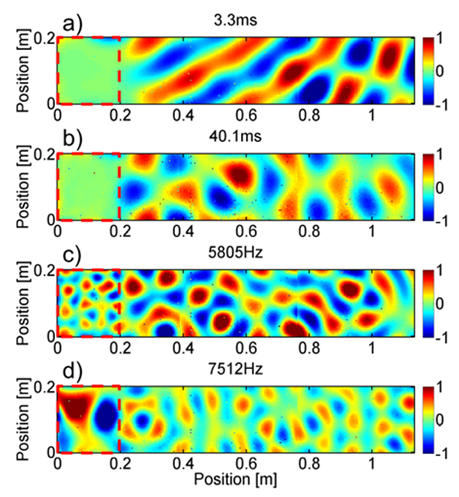Towards seismic metamaterial
Note that forests have been studied in the 1990’s for their scattering properties with respect to acoustic waves in air (Price et al, 1988). However, the poor sensitivity of microphones and the difficulty of setting up a large number of acoustic sources and microphones under outdoor conditions has limited such an analysis to the measurement of an attenuation coefficient associated with both foliage and trunk scattering. More recently, the acoustic properties of a dense collection of regularly-ordered bamboos were studied at the laboratory scale (Lagarrigue et al, 2012) and proved to behave as a phononic cristal with the presence of frequency bandgaps.
The META-FORET project is completely different from these two approaches, as we intend to deal with seismic surface waves that propagate in the ground (and not in air) interacting with :
- a dense collection of vertical trees lying of the ground and,
- long cylindrical concrete inclusions buried in the ground.
As a seismic metamaterial, we expect that a forest induces some frequency bandgaps where no seismic energy can travel, as well as complex dispersion curves that generate sub-wavelength and supra-wavelength modes. Moreover, assuming the correct design of the forest, with trees of different heights, we believe that there may also be some frequency bands with negative refraction index, thus generating a cloaking phenomenon, which is also called a ‘cape of invisibility’. The demonstration that metamaterial physics exists at a very large scale in our natural environment would be a major breakthrough in this very active domain of research. Indeed, relatively few mesoscopic scale experiments (e.g., at the meter scale or larger) have been achieved to date with metamaterials, most practical applications having dealt so far with optical waves at the millimeter, or even micrometer, scales. The possibility to apply and experimentally demonstrate that the same physics can be observed at the geophysics scale (e.g., scales ranging from 10 m to 100 m) will then be a striking result.
Since 2013, Philippe ROUX and his team have been investigating the propagation of elastic waves in a system formed by a set of aluminum rods glued to a thin aluminum plate (1.5 m × 1.5 m, see Fig. 1). A collection of 100 long rods (length, 61 cm) was attached perpendicularly to the plate inside a 20 cm × 20 cm square. These thin rods (diameter, 6 mm) form a set of quasi-punctual resonators that were comparable to the average wavelength of the flexural waves in the plate (around 0.2 m) in the propagation plane of the waves. It was possible to arrange these rods periodically or randomly on a sub-wavelength scale.
The combination of these 100 rods glued to the plate provided an original metamaterial at the mesoscopic scale, mimicking the forest experiment at the laboratory scale. Due to the strong reverberation at the plate boundaries, the experiment showed a complex diffuse wave field within the plate that included wide bandgaps inside the metamaterial. In collaboration with G. LEROSEY at Institut Langevin (Paris) and S. GUENNEAU at Institut Fresnel (Marseille), the experimental and numerical approaches confirmed the hybridization phenomenon between the dominant flexural A0 mode in the plate and the compressional resonances inside the rods (Fig. 2).
Within this context, the goal of the META-FORET project is to unveil the link between the metamaterial experiments performed with rods glued to a plate at the laboratory scale and the demonstration that a forest (made or regular trees or buried concrete columns) can behave in the same way at the geophysics scale for seismic waves, using the deployment of a dense seismic array to map out the wavefield complexity.

As a matter of fact, ISTerre organized in July 2014 a spectacular experiment on the slopes of the Piton de la Fournaise Volcano, where more than 300 autonomous seismic sensors (with no wires) were deployed to record continuous ambient noise following a volcanic eruption (Brenguier et al, 2016). As shown in a recent publication published in Science by CalTech in South California, the use of a large number of sensors (more than 5000) to perform spatially dense and continuous seismic acquisitions is a new trend in geophysics that was nearly inconceivable five years ago. It seems now obvious from the recent technological developments that lead academic partners to the use of very dense and large arrays of wireless seismic sensors that we reached a critical stage where the incredible quality of geophysics measurements has begun to overtake our understanding of the underlying physics processes in Earth sciences.

Within this international context, the goal of the present project is to unveil the link between the metamaterial experiments performed with rods glued to a plate at the laboratory scale and the demonstration that a forest can behave in the same way at the geophysics scale for seismic waves, using the deployment of a dense seismic array that has been made possible by recent technological developments.
At the national level, the timing of the META-FORET project perfectly matches the creation of a new Research Group in January 2016 (also called GDR for "Groupe de Recherche") funded by CNRS on Acoustic Metamaterials. More precisely, the GDR META : "METamatériaux Acoustiques pour l’ingénierie", aims at structuring the French community working on this topic for the next five years through a set of workshops and collaborations between academic and industrial partners. Both P. ROUX at ISTerre and S. GUENNEAU at Institut Fresnel are members of the GDR META board and in charge of the thematic group on "Emerging fields". The PhD student and the post-doc funded by the META-FORET project at ISTerre and Institut Langevin will then wholy benefit from this stimulating national environment.
Updated on 10 octobre 2016


